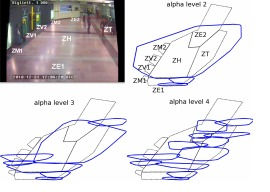Section: New Results
Online Activity Learning from Subway Surveillance Videos
Participants : Jose-Luis Patino Vilchis, Abhineshwar Tomar, François Brémond, Monique Thonnat.
Keywords: Activity learning, clustering, trajectory analysis, subway surveillance
This work provides a new method for activity learning from subway surveillance videos. This is achieved by learning the main activity zones in the observed scene by taking as input the trajectories of detected mobile objects. This provides us the information on the occupancy of the different areas of the scene. In a second step, these learned zones are employed to extract people activities by relating mobile trajectories to the learned zones, in this way, the activity of a person can be summarised as the series of zones that the person has visited. If the person resides in the single zone this activity is also classified as a standing. For the analysis of the trajectory, a multiresolution analysis is set such that a trajectory is segmented into a series of tracklets based on changing speed points thus extracting the information when people stop to interact with elements of the scene or other people. Starting and ending tracklet points are fed to an advantageous incremental clustering algorithm to create an initial partition of the scene. Similarity relations between resulting clusters are modelled employing fuzzy relations. A clustering algorithm based on the transitive closure calculation of the fuzzy relations easily builds the final structure of the scene. To allow for incremental learning and update of activity zones (and thus people activities), fuzzy relations are defined with online learning terms. The approach is tested on the extraction of activities from the video recorded at one entrance hall in the Torino (Italy) underground system. Figure 33 presents the learned zones corresponding to the analyzed video. To test the validity of the activity extraction a one hour video was annotated with activities (corresponding to each trajectory) according to user defined ground-truth zones. After the comparison, following results were obtained: TP:26, FP:3, FN:1, Precision:0.89, Sensitivity:0.96. This work is published in [43] .
|



